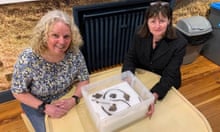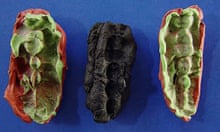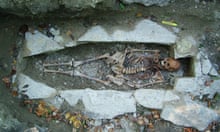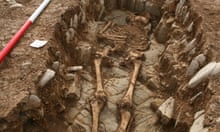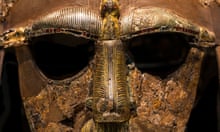Researchers in Scotland hope to unlock the secrets of a stunning Viking-age hoard after a receiving a £1m grant to examine the provenance of the 10th century haul that lay undisturbed for a thousand years before being unearthed by a metal detectorist.
The incredible discovery of the Galloway Hoard, comprising more than 100 objects including silver jewellery and ingots, was made in September 2014 in a field in Dumfries and Galloway. It has since been acquired by National Museums Scotland (NMS).
NMS will carry out a three-year project, “Unwrapping the Galloway Hoard”, in partnership with the University of Glasgow, to examine in detail the objects, due to go on display in an exhibition next year.
The haul contains an unparalleled range of precious metal and jewelled items, including a rare gold ingot, a unique gold bird-shaped pin and a decorated silver-gilt vessel, the only complete lidded vessel of its type ever discovered in Britain and Ireland.
Inside the vessel were beads, amulets of glass and rock crystal, a silver penannular brooch and five Anglo-Saxon disc brooches not previously found in Scotland. Parts of the find were wrapped in fragile textile bundles.
Taken altogether, the hoard hints at hitherto unknown connections between people across Europe and beyond, and, according to researchers, it provides a rare opportunity to research and reveal many lost aspects of the Viking age.
The research will involve precise dating of the items and, it is hoped, identification of their places of origin, which are thought to range from Ireland to the Byzantine empire and, perhaps, beyond.
The Arts and Humanities Research Council has awarded a £791,293 grant for the project, with the remaining cost covered by the NMS and the University of Glasgow.
“Most hoards are usually interpreted as buried wealth, with the focus on events surrounding the moment of burial,” said Martin Goldberg, principal curator of medieval archeology and history at NMS. “The Galloway Hoard challenges this view and presents a rare opportunity to ask in much more detail about how, and why, people assembled and collected hoards during the Viking age.
“We’ve already discovered a great deal through conservation work, and people will be able to see that in the forthcoming exhibition. However, this research project will enable us to go much further using scientific techniques and international collaboration.”
Susanna Harris, lecturer in archeology at the University of Glasgow and co-investigator, said that as well as the silver familiar with most Viking-age hoards, and the much rare gold, the Galloway collection also featured an “unprecedented array” of other materials such as bronze, glass and rock crystal.
There was also the “outstandingly rare preservation of organic materials”, such as wood, leather, wool, linen and Scotland’s earlier example of silk, she said, “which could have traveled thousands of miles to reach Scotland.”
“Unwrapping the hoard, literally and figuratively, is a unique and wonderful opportunity,” added Harris.
The Galloway Hoard: Viking-age Treasure exhibition is due to open at the NMS in Edinburgh on 19 February, and then tour to Kirkcudbright Galleries and Aberdeen Art Gallery.

